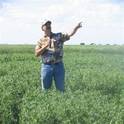
Little information is available regarding comparative forage quality of alfalfa (Medicago sativa L.) leaves and stems of the nine germplasms from which most North American cultivars have been developed. In a greenhouse trial, forage quality of leaves and stems of the nine germplasms was compared when grown in a common environment and harvested at the same phenological stage. Germplasm sources (and representative cultivar) tested were: Indian (Sirsa #9), African (African), Peruvian (Hairy Peruvian), Flemish (DuPuits), Turkistan (Lahontan), Chilean (Kansas Common), M. varia Martin (Grimm), Ladak (Ladak), M. falcata L. (Anik). Leaves of germplasm sources differed for concentrations of neutral detergent fiber, cellulose, crude protein, true in vitro digestible dry matter, and p-hydroxybenzaldehyde, vanillic, p-coumaric, ferulic, and sinapic acids. Stems of germplasm sources differed for concentrations of NDF, hemicellulose, CEL, TIVDDM, and p-hydroxybenzoic, syringic, p-coumaric, and ferulic acids. Results indicate that alfalfa germplasm sources differ in nutritive value of leaves and stems.
Available at: http://works.bepress.com/andrew_lenssen/10/
